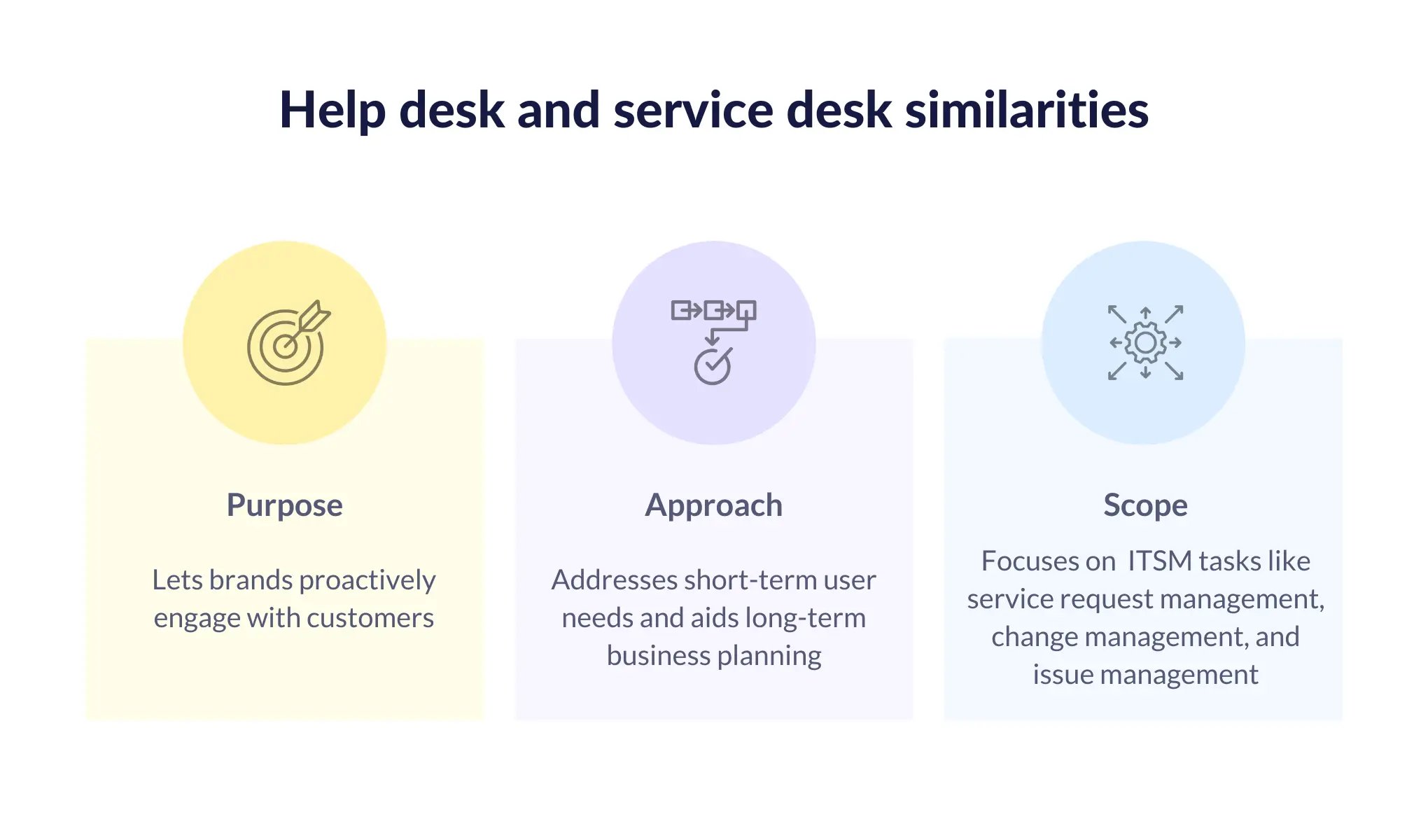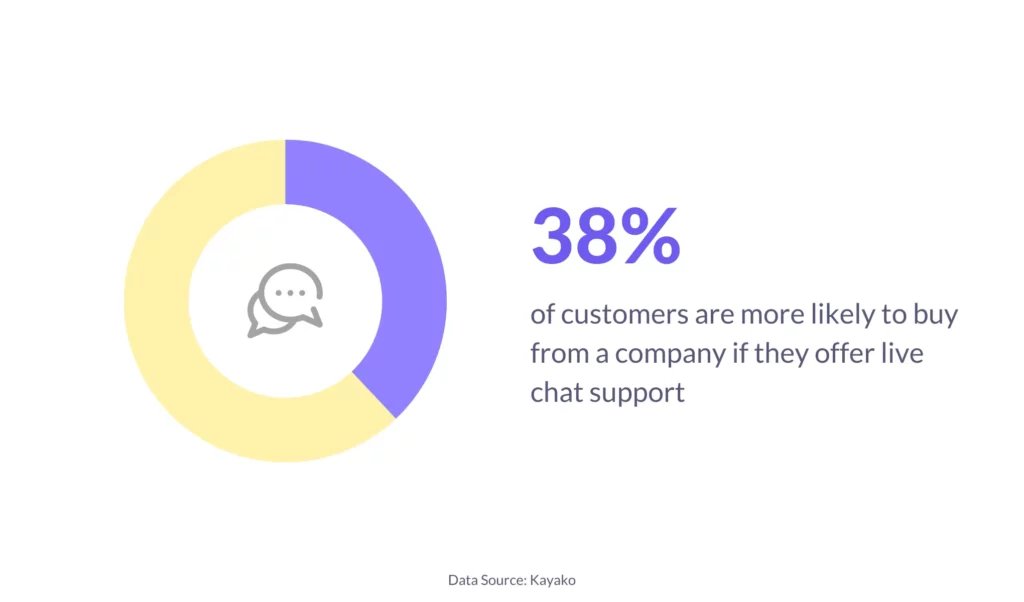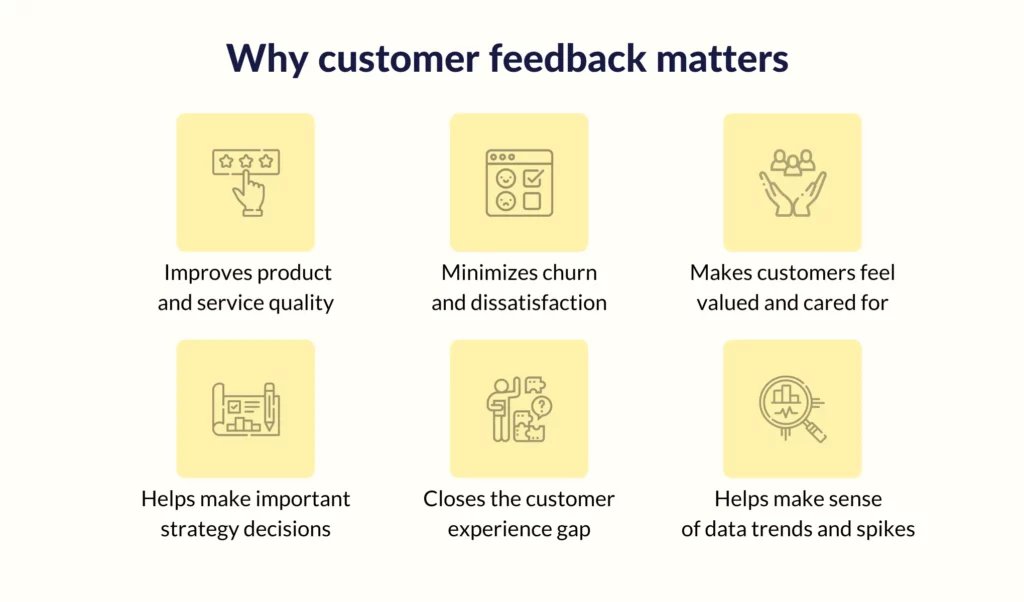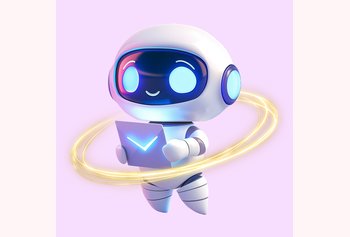Help Desk vs Service Desk: What’s the Difference?

Table of contents
Ever wondered if there’s a difference between a help desk and a service desk? Spoiler alert: there is! While they might seem like two sides of the same coin, understanding the nuances can significantly impact your customer support operations.
Many customer service professionals use service desk and help desk interchangeably. This common confusion can lead to misaligned support services and unmet expectations.
So, what sets them apart, and why does it matter for your support team?
In this article, we’ll dive into the differences of help desks vs. service desks, highlighting how each plays a crucial part in delivering support. We’ll explore how both these systems enable smoother internal operations and minimize disruptions but in different ways.
Key Takeaways
Here is a summary of the key differences:
| Parameters | Helpdesk | Service desk |
|---|---|---|
| Level of Service | Quick fixes for tech snags. | Broader range of IT services, system updates info. |
| Scope | Addresses immediate glitches swiftly. | Digs deeper to prevent future glitches, coordinates with other IT processes. |
| Activity | Incident resolution, password resets, basic troubleshooting. | Service requests, change management, knowledge sharing. |
| Skills Required | Technical know-how, communication skills. Basic diploma or certifications like CompTIA ITF+. | Broader technical expertise, project management. Bachelor’s degree and certifications like ITIL® Foundation. |
| Cost and Maintenance | Cost-effective, major on staffing and basic tools. Low maintenance. | Step up in cost due to broader services and advanced software. Ongoing training for staff. |
| Tools Used | Support solutions for ticketing, omni-channel support for communication. | Advanced ticketing software like ServiceNow, tools for change and asset management. |
Table of Contents
- Key Takeaways
- What is a help desk?
- What is a service desk?
- Help desk vs. Service desk
- 1. Based on Level of Service
- 2. Based on Scope
- 3. Based on Activity
- 4. Based on Skills Required
- 5. On the basis of Costs and Maintenance
- 6. On the basis of Tools Used
- Features to look for in a help desk or service desk tool
- Power your customer service with user-friendly software
- FAQs
What is a help desk?
What exactly is a help desk? In essence, a help desk is a dedicated team equipped with specialized software to address technical issues efficiently. Whether it’s a lost password, software hiccups, or any hardware malfunctions, the help desk is your go-to resource for resolving these one-off technical issues.
Picture this: Your computer freezes when you’re working. Who do you get in touch with? The help desk.
They’re like the technical ER (Emergency Room) of your company, there to diagnose your IT ailments and patch things up quickly.
The help desk didn’t just pop up out of nowhere; it has been a crucial part of companies since the 1980s, primarily focusing on reactive support. However, just like an ER, it can get overwhelmed, leading to those frustratingly slow or unhelpful responses that some users might have experienced.
Did You Know?
Since the 1980s, help desks have evolved from basic IT troubleshooting units to comprehensive service centres. They’re now integrate to multiple functions—customer support, sales, and IT service management (ITSM) amongst others.
What is a service desk?
Think of a service desk as the central hub of communication between a company and various stakeholders—customers, employees, vendors, and partners. A service desk is not just about fixing immediate tech glitches; it also tackles broader, ongoing issues.
Service desk agents do more than just answer calls; they manage queries about products and guide users through new updates or services.
Imagine a service desk as the concierge of a large hotel. Just like a concierge who helps guests with everything from check-in to local recommendations and problem resolution, service desks provide a comprehensive support system.
They handle everything from routine service requests for new features to managing extensive knowledge bases and self-service tools like chatbots. Moreover, service desks keep track of how well they’re doing through detailed reporting on performance and customer satisfaction.
This makes the service desk a more encompassing system compared to a help desk, which has a narrower scope. Yet, both are essential to ensuring your operations run smoothly.
Help desk vs. Service desk
Many businesses use these two terms interchangeably. A company may call its service desk a help desk because the latter is more common. At the same time, another company may call its help desk a service desk because the company wants it to seem more service-oriented. But let’s understand their differences based on different parameters:

1. Based on Level of Service
Helpdesk:
The level of service here is straightforward. When you hit a tech snag, like a forgotten password or a software that’s acting up, you typically reach out to the helpdesk. They’ll assist you with a reset or a workaround, ensuring you can swiftly move on with your day.
Service Desk:
The service desk steps it up a notch. It’s like your go-to for a broader range of IT services. Got an issue with your computer? They’ll sort it out. They’re also the friendly neighborhood IT folks keeping you in the loop about system updates or changes.
Now, say you need a new software installed. You ring the service desk. They not only handle the installation but also ensure you know how to use it. They’re also the folks who’ll let you know when there’s a system update and guide you through it.
2. Based on Scope
Let’s take the example of handling a software glitch that’s preventing employees from accessing a crucial database:
Helpdesk:
When you first encounter this glitch, the helpdesk is your initial call. They’ll dive into the issue, aiming for a quick fix to get you back on track. Maybe they’ll guide you on a workaround or reset the software to resolve the immediate issue. Their service is about swift resolutions to keep your day moving.
Service Desk:
Now, the service desk goes a bit farther. Besides addressing the glitch, they might look into why it happened and how to prevent it. They could coordinate with other IT processes, ensuring that not just you, but the whole team or department, doesn’t run into the same glitch down the line. It’s more about a comprehensive service to ensure smoother operations.
3. Based on Activity
Helpdesk:
- Incident Resolution: Sorting out day-to-day issues like a frozen computer or a malfunctioning printer. For example, guiding you on restarting a stalled application.
- Password Resets: Helping reset passwords when you’re locked out of your account.
- Basic Troubleshooting: Offering basic solutions like rebooting hardware or updating software to fix common problems.
Service Desk:
- Service Requests: Handling requests for new hardware or software. For example, installing a new software suite you need for a project.
- Change Management: Coordinating IT changes like software upgrades to ensure minimal disruption.
- Knowledge Sharing: Providing guides or advice on how to use certain applications or adhere to IT policies.
Recommended Read:
Top 11 IT Help Desk Software To Watch Out For in 2024
4. Based on Skills Required
Helpdesk:
- Technical Know-how: A solid understanding of common software and hardware issues is key. Knowing how to troubleshoot common problems like network connectivity issues or software bugs is essential.
- Communication Skills: Being able to explain tech jargon in simple terms is crucial. It’s all about helping users understand the fix.
- Patience and Problem-Solving: Sometimes issues can be tricky or users might be frustrated. Keeping a cool head and working through the problem step-by-step is the game.
- Education/Certification: Usually, a basic diploma or an associate degree in IT or related fields is beneficial. Certifications like CompTIA IT Fundamentals (ITF+) can be a plus.
Service Desk:
- Broader Technical Expertise: A step up from the helpdesk, this role requires a good grasp of IT processes and more complex systems.
- Project Management: Handling various requests and managing changes efficiently is part of the drill.
- Interpersonal Skills: Building relationships between IT and other departments is key. It’s about ensuring everyone’s on the same page regarding IT services and changes.
- Education/Certification: A bachelor’s degree in IT or a related field is often preferred. Certifications like ITIL® Foundation or CompTIA A+ can be beneficial.
5. On the basis of Costs and Maintenance
Helpdesk:
Generally, the most cost-effective as it deals with basic IT support. The major expenses might include staffing and basic tools for ticketing and communication. Maintenance costs could be lower too, focusing on keeping the helpdesk software updated and training staff on basic troubleshooting techniques.
Service Desk:
There will be a step up in cost due to a broader range of services and possibly more advanced IT service management software. Ongoing training for staff to keep up with evolving IT processes and technologies could add to the maintenance costs.
6. On the basis of Tools Used
Helpdesk:
With a helpdesk, the tools are pretty straightforward. Think of a simple ticketing system where you report an issue, and they track it. For instance, any support software like Hiver or Zendesk might be used to log your call, track the issue, and ensure it’s resolved. They also provide omnichannel support, enabling you to reach out via live chat, access a knowledge base, or use voice support to find a quick fix.
Service Desk:
Now, step into the service desk arena, and the tool belt gets a bit more fancy. They might use more advanced versions of ticketing software that can automate certain processes, like routing your request to the right tech person. They also have tools that help with change management or asset management.
A tool like ServiceNow can help not just with tracking issues but also managing IT changes, ensuring nothing falls through the cracks. Whether it’s incident, problem, or change requests, a unified interface like ServiceNow’s helps in prioritizing and handling requests efficiently. Its strong integration capabilities allow for a seamless connection with other business applications, creating a cohesive ecosystem.
Features to look for in a help desk or service desk tool
Empower your support team to communicate with customers smoothly, fix issues quickly, and handle their workload easily with these tools and workflow automation.
1. Visibility into your team’s workload
When you can see the support requests each agent is handling, you’ll be able to redistribute and balance out their workload, in a more efficient way.
A help desk software like Hiver gives you viewing and workload allocation features that let your team respond to clients quickly — without burning out.
2. Live chat widget
A live chat widget is a little chat box you add to the bottom of your website or mobile app to allow customers or employees to talk to support agents.
Use a service or help desk solution that offers live chat so your support reps can resolve issues, engage leads, and send self-service options through chat in real-time.

3. Comprehensive analytics on agent performance
Track agent performance with a help desk or service desk tool that generates in-depth reports, including:
- Conversation reports that let you seehow your team is managing customer messages — from how many conversations each agent is handling to individual turnaround time.
- User reports that cover every part of individual agent productivity and show what top performers are doing better than less efficient agents.
- Tag reports that let you monitor customer conversations by their tag names — like critical or low priority — find common trends or blockers and tackle them.
- Custom reports that give insight into any agent performance metric you need without having to code, use another tool, or hire a data analyst. Say you want to track how many critical conversations your team has resolved; you can create a “critical resolved conversations” report.
These reports will also help you reward top-performing agents and train your team based on their skill gaps.
4. Service level agreement (SLA) management
Service level agreements (SLAs) keep customer support reps accountable for responding to requests in a timely manner. Imagine you set an SLA for five hours. If no agent has picked up a customer query in that time period, your service desk or help desk software alerts managers so that they can step in.
Select a help or service desk tool that lets you:
- Set up multiple SLAs around your business hours
- Add automatic SLA violation tags
- Get notifications for SLA violations
Improve your IT management processes and service delivery by tracking SLAs based on preset business hours — for one location or across multiple time zones.
5. Customer surveys
According to research, 57% of customers are loyal to brands with good customer service. Use a help or service desk tool’s customer survey feature to understand what your audience thinks about the support they get — and improve accordingly.
Control how you collect feedback with a software that lets you customize and send customer surveys after specific support interactions.

6. Data security
Cybersecurity is a concern for every business that operates online. Stay prepared by using a help desk or service desk software that keeps your data safe with airtight security features. Incorporating knowledge from the OSI model explained with examples can help in understanding how data flows and is secured across different network layers.
Many software companies list their data protection processes on their website security page — like third-party security audits, incident response policies, use of no logs VPNs with authentic providers, vulnerability disclosure programs, and more.
Check that the help or service desk you choose has a solid privacy policy and clear guidelines for how:
- It stores and backs up user data
- Its software interacts with third parties
- The software verifies user access
Power your customer service with user-friendly software
There are so many help or service desk software options to choose from today. Even when you know the features to look for, selecting the one that fits your business needs can be a challenge.
To make a decision, shortlist products that have the right functionalities, then sign up for free demos and trials. This process will help you find a tool that’s easy to use and customizable to your business needs.
FAQs
1. What is a Help Desk in IT?
A help desk in IT is a focused department that addresses customers’ or employees’ technical issues, such as software glitches, connectivity problems, or system crashes.Such a help desk turns queries and complaints into ‘incidents’ and gives team members the ability to assign, track, and collaborate on these incidents – for faster resolution.
2. What is the difference between a Help Desk and a Service Desk?
A help desk typically addresses one-off technical incidents. A service desk, on the other hand, provides a broader range of IT services, including managing recurring issues, and offering knowledge management (organizing and sharing information about the product/service with customers).
3. What are the key features to look for in a Help Desk or Service Desk Tool?
Key features include workload visibility, live chat widgets, comprehensive analytics, SLA management, customer surveys, and robust data security measures.

































